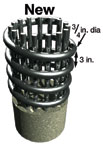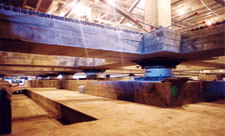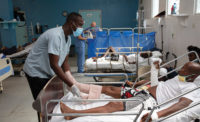 |
| REBAR RETROFITS After lateral forces blew out bridge support steel, Caltrans adopted beefier, spiral-wound design (below). (Photo courtesy of FEMA) |
"Were always fighting against the last earthquake we experienced...instead of trying to look ahead to see whats on the horizon and fix the problem," says Thomas H. Heaton, a geology professor at California Institute of Technology in Pasadena who studies the structural impact of earthquakes. He calls for a greater dialogue between engineers and earth scientists. Despite common interests, they "continue to talk past each other on some of these issues," he contends.
|
The damage sustained by buildings accounts for a significant share of the quakes human and economic costs57 deaths, 1,500 serious injuries, $40.6 billion in losses. Some 12,500 buildings sustained moderate to severe damage, 7,000 were deemed unsafe, and 25,000 housing units were rendered uninhabitable. Bob Steinbach, assistant bureau chief for Los Angeles Dept. of Building and Safety, asserts that "trends in design and construction have gone very, very conservative."
Peer review and quality assurance in structural design has improved, yet too few consultants are qualified to advise clients in mitigating economic impact, argues Nabih Youssef, president of Nabih Youssef & Associates, a Los Angeles-based structural engineer. As a result, owners "get expensive solutions so they back off," he contends.
In the past decade, Los Angeles and other cities have seen the rise and decline of big-ticket methods like base isolation, which remains popular for critical facilities. A $300-million renovation made Los Angeles City Hall the tallest U.S. building to use base isolation modified with viscous dampers (ENR 6/25/01 p. 16). Preserving and restoring landmarks "is not only a good idea from a cultural point of view, its very economical," claims Christopher C. Martin, CEO of AC Martin Partners, architect and engineer for the renovation.
 |  |  |
On the structural side, the number- one development cited by engineers is the upgrade in steel moment frame design prompted by the discovery of fractured connections in about 200 buildings. An $11-million, six-year study by the SAC Joint Venture developed nine alternatives to the pre-Northridge details. Those connections allowed column flanges welded to a beams top and bottom flanges and a shear plate welded to the column flange and bolted to the beam web (ENR 8/14/00 p. 13).
The recommended details vary to accommodate different climates and building sizes, but all require tougher weld material than the old connection. The "dogbone" detail uses trimmed beam flanges to reduce stress concentrations at the column. The Chicago-based American Institute of Steel Construction is expected to standardize the details in its 2005 specifications and may incorporate them into the 2006 model codes, says James O. Malley, senior principal at San Francisco-based Degenkolb Engineers and president of the Structural Engineers Association of California.
The Federal Emergency Management Agency is advocating a multiple-hazard approach to design that integrates wind, flood and seismic issues, notes Malley. Seismic issues historically rank highest among California engineers, but "for the most part I think people are open to it," Malley says, because many engineers based in the state also practice elsewhere.
For all the attention paid to moment frames, many see far more urgent risks. Only last month, the magnitude 6.5 central California earthquake provided an all-too timely reminder when a century-old unreinforced masonry building collapsed, killing two (ENR 1/12 p. 16). URM buildings will "continue to be a primary cause of deaths and economic losses in future earthquakes," warns Fred Turner, senior structural engineer with the California Seismic Safety Commission. In Iran, URMs were blamed for most of the estimated 30,000 deaths in a magnitude 6.5 quake in January.
Non-ductile concrete buildings also pose a significant risk. Most of the 800 in Los Angeles escaped untested in 1994 because "the really big shaking in Northridge happened where the non-ductile buildings largely were not," according to CITs Heaton.
A proposed city ordinance requiring upgrades of pre-1975 buildings "died in the political process and it remains a recommended standard," notes C. Terry Dooley, who retired in 2002 as senior vice president at Santa Monica-based Morley Construction Co.
 |
| STEADY ON Los Angeles City Halls $300-million retrofit added a large base-isolation system that depends on viscous dampers. (Photo courtesy of Taylor & Company) |
Northridge will continue to influence hospital planning for at least another decade. State law now requires acute-care facilities to meet life-safety standards by 2008. Many hospitals will replace rather than upgrade 1,000 buildings that fall short, says Chris Tokas, seismic upgrade program director at the Office of Statewide Health Planning and Development.
The states longest-running retrofitting program is the California Dept. of Transportations nearly complete $2.2 billion effort to retrofit over 2,100 bridges statewide. The collapse of nine freeway bridges in the Northridge quake underscored the importance of the program that began in response to the 1989 Loma Prieta earthquake.
To prevent rebar displacement and column deformation that marked many damaged bridges, Caltrans retrofit columns with steel or composite casings around each column, says Mike Keever, chief of Caltrans office of earthquake engineering. New bridge design emphasizes strong decks and foundations and transferring damage into the ductile regions. "The way we detail them, they can bend without breaking," Keever says.
en years after the Northridge earthquake sounded its early morning wake-up call on Jan. 17, 1994, its shock waves continue to shape design and construction in Los Angeles and beyond. The magnitude 6.7 quake shook assumptions, sparked design changes and unleashed a wave of retrofitting and replacement that continues today. Despite many positive strides, observers warn that failure to address some critical issues poses a continuing risk.

Post a comment to this article
Report Abusive Comment